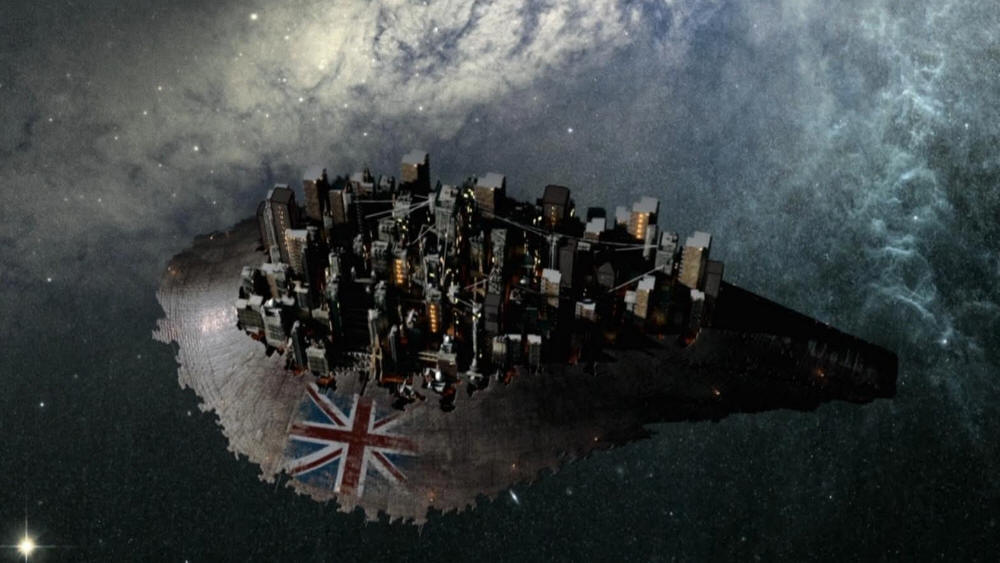
C+Q - The Beast Below (2010)

After a baffling pre-title sequence with a little girl
reciting a creepy poem which is never explained or even
referenced again, we're treated to a lovely scene of Amy and the
Doctor in the TARDIS. It's just a really fun sequence and the
image of Amy floating in space outside the TARDIS is beautiful
and instantly iconic of Series 5. Like with last week's episode,
the fairytale vibes are very strong here. My favourite design
choice of the Moffat era has to be the decision to replace the
old rusty, weathered looking TARDIS to the much cleaner and
happier-looking current model. It's absolutely gorgeous and when
Amy steps out of it and into the distinctly British interior of
Starship UK, it fits in really well.
Speaking of which, the design of Starship UK is brilliant. From
the crowded main street where the TARDIS lands, to Liz 10's
grand bedroom, to the brickwork in the tower of London; it all
looks unique and unlike a conventional space station episode.
It's a bizarre mix of standard British iconography with
futuristic technology (which will be why Dr Who's TARDIS fits in
so well). Conceptually, Starship UK and the means by which it's
travelling through space is a very creative idea and it makes
for a good set-up. The Beast Below puts the Doctor and Amy in
secondary roles while Starship UK is the real star here.
The script gives new companion Amy Pond a lot to do and
separates her from the Doctor very quickly. We get to see how
she explores the new world around her and the ways she's
different to the Doctor. Unlike Clara who is very caring towards
children due to the loss of her own mother, Amy seems to
immediately dismiss Mandy, almost acting like a big kid herself.
The character of Amy really is a fantastic creation, played
brilliantly by Karen Gillan. Unlike Rose, Martha, and Donna
during their first trips, she doesn't need the Doctor to act as
her tour guide and on her very first adventure with him, she
ends up going off on her own, making her own discoveries, and
even saving the day at the end when she notices that the Star
Whale would never kill the children.
Unfortunately, The Beast Below is far from being perfect. Steven
Moffat himself was quoted in 2013 saying that this story was a
bit of a mess, and I can see where he was coming from. Take Liz
10 for example. Why does she wear a mask? No really: why? She
meets the Doctor and is seen wearing the mask in the shadows,
but the Doctor has no idea who she is anyway, so why is the mask
necessary? As soon as she meets Mandy, she takes it off and says
"It's alright love, it's only me!" So does Liz 10 have some
history with Mandy? Or does Mandy just recognise her because
she's the bloody queen? And if she's just going to take off the
mask anyway, why would she bother wearing it? Was she trying to
stay hidden from the government? Okay, I suppose that makes
sense. Or rather, it would, if the government didn't literally
know where she lives, and have the ability to march into her
bedroom at any moment.
Also, are the government with Liz 10 or against her? You'd think
they were with her, because they help her at the start by
telling her that the Doctor did 'the thing'. But then again, why
would she ask the government to keep a lookout for her if she
knew that they were keeping secrets from her? The moment you
start to think about this story, it completely falls apart, but
I still like The Beast Below despite its flaws. Part of that is
down to the performances and part is down to the aesthetics. I
like all the old-fashioned stuff on a grimy spaceship. I like
Liz 10 and her cool mask and cool guns even if wearing a mask
makes no sense. I can enjoy the moment to moment happenings of
this episode as long as I don't take too far of a step back and
end up seeing that the bigger picture is falling apart. The
Beast Below is Moffat's weakest 2010 script for me, but it's
still great fun to watch (which should be an indication of how
well Moffat was doing during this early period of his tenure).
At the end of the episode, we see the Doctor getting a phone
call for Churchill, setting up next week's adventure. I love
this old style of serialisation, like with the old Hartnell
episodes, where each one would end with the TARDIS crew arriving
at their next destination. It gives the feeling that the show
chronicles the Doctor's aimless wanderings through time and
space looking for adventure rather than trying to solve some
grand mystery. Again, huge series-arcs are great (in fact, this
episode ends with a crack in time on Starship UK, foreshadowing
events all the way up to The Time of the Doctor), but I love it
when Who does these quieter adventures fuelled only by the
desire to have fun and explore the universe.
Next: Victory of the Daleks